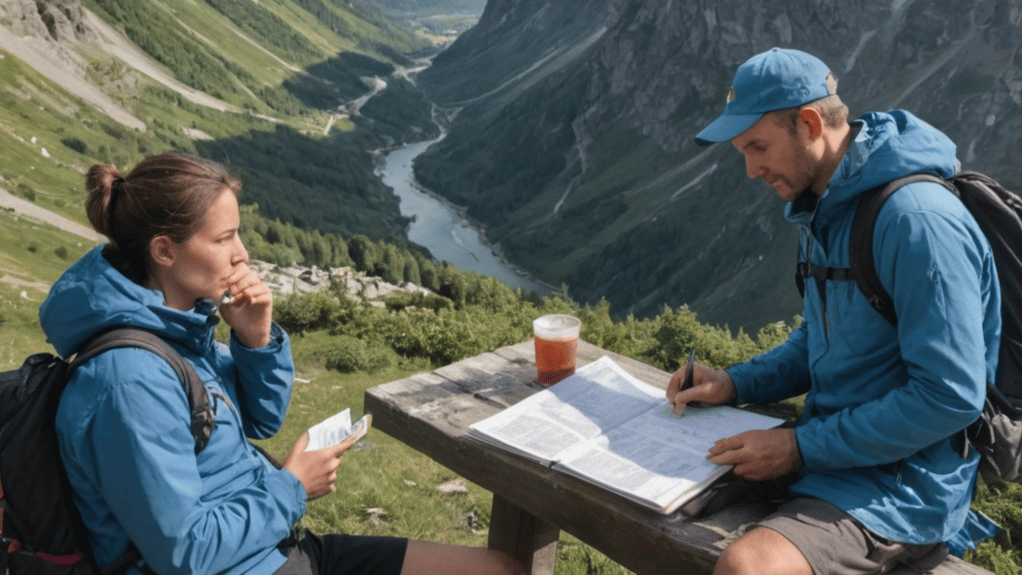Mont Blanc, renowned for its stunning vistas and diverse outdoor activities, beckons adventurers worldwide. It offers climbing, hiking, and skiing adventures, each discussed across chapters for in-depth exploration:
Climbing and Mountaineering: The mountain's iconic summit, accessible via routes for all, symbolizes a climber's achievement.
Hiking and Trekking: Featuring the world-renowned Tour du Mont Blanc and the UTMB race, Mont Blanc stands as a top hiking destination with its magnificent trails.
Other Outdoor Sports: From glacier travels to thrilling via ferratas and unparalleled ski-touring, Mont Blanc offers year-round adventures.
Your adventure likely starts in Chamonix, France, or Courmayeur, Italy—gateways to this alpine wonder. These vibrant communities serve as base camps, offering direct access to Mont Blanc's challenges and beauty. Upcoming chapters will guide you on itineraries, preparation tips, and insights for an unforgettable Mont Blanc experience.
The following chapters will offer you tips and insights collected during the last 3 years of climbing and hiking trips around Mont Blanc:
Hiking itineraries you shouldn't miss around Mont Blanc
Alpinists in the making: The easiest routes to the Mont Blanc summit
The Rock Climber's Guide for Mont Blanc
Other Outdoor activities you can practice around Mont Blanc
Costs and Budgeting for Traveling to Mont Blanc, Chamonix and Courmayeur
Things to know before going on a climbing and hiking adventure around Mont Blanc
Best ways to access Chamonix, Courmayeur and Mont Blanc
Conclusions
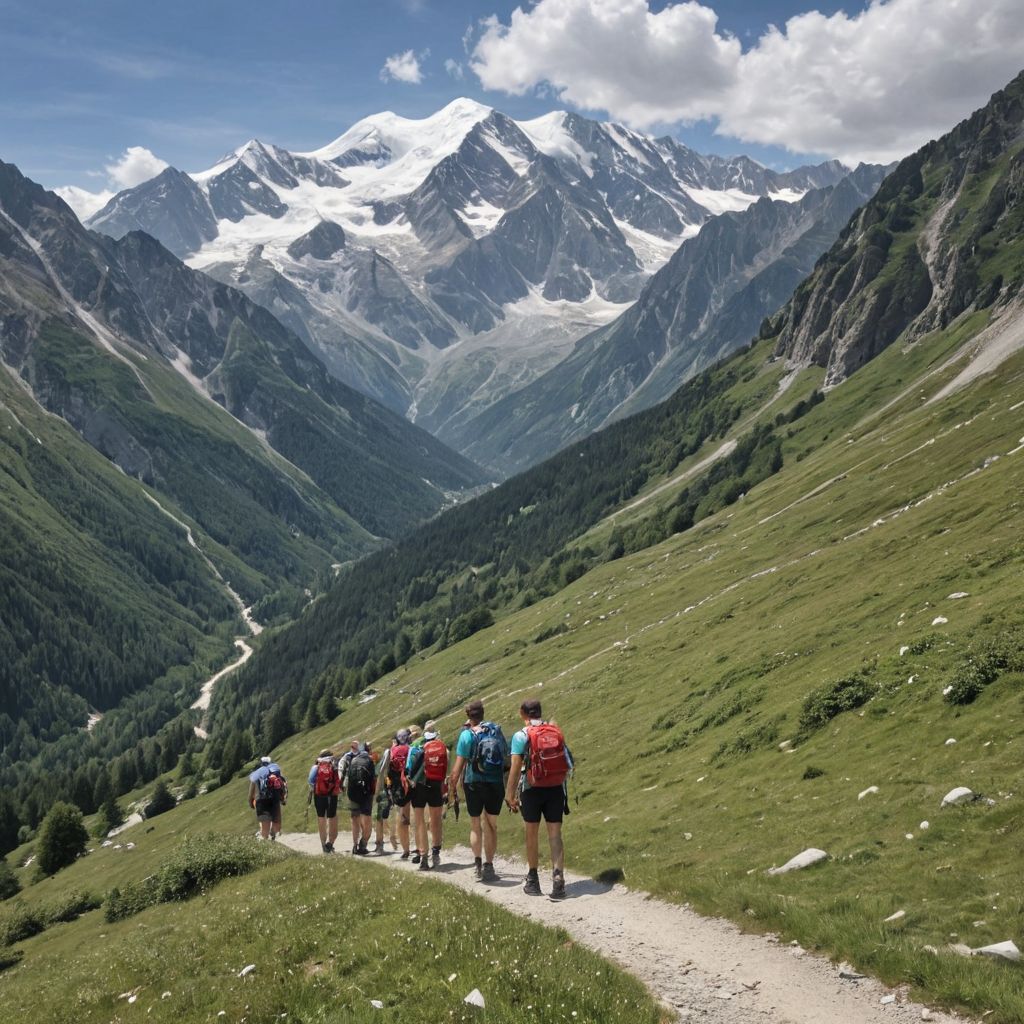
1. Hiking itineraries you shouldn't miss around Mont Blanc
Hiking and Trekking around Mont Blanc: Tour du Mont Blanc
The Mont Blanc massif offers a rich selection of hiking and trekking opportunities that attract enthusiasts from across the globe. Amidst this alpine paradise, the Tour du Mont Blanc (TMB) stands out as a premier hiking trail, encircling the massif and traversing through three countries: France, Italy, and Switzerland.
The Tour du Mont Blanc: A Hiker's Dream
The Tour du Mont Blanc (TMB) is a highlight for trekking enthusiasts, offering a scenic path around the Mont Blanc massif across France, Italy, and Switzerland. This trail spans about 170 kilometers, climbing a total of roughly 10,000 meters. Typically completed within 7 to 10 days, the TMB takes adventurers through varied terrains and cultures, offering stunning alpine views. It's accessible to a broad range of hikers, including a 4-day version for those seeking a more accessible experience. For those interested in embarking on this iconic trek, our comprehensive guide to hiking the Tour du Mont Blanc provides invaluable insights into planning, tips, and cost considerations.
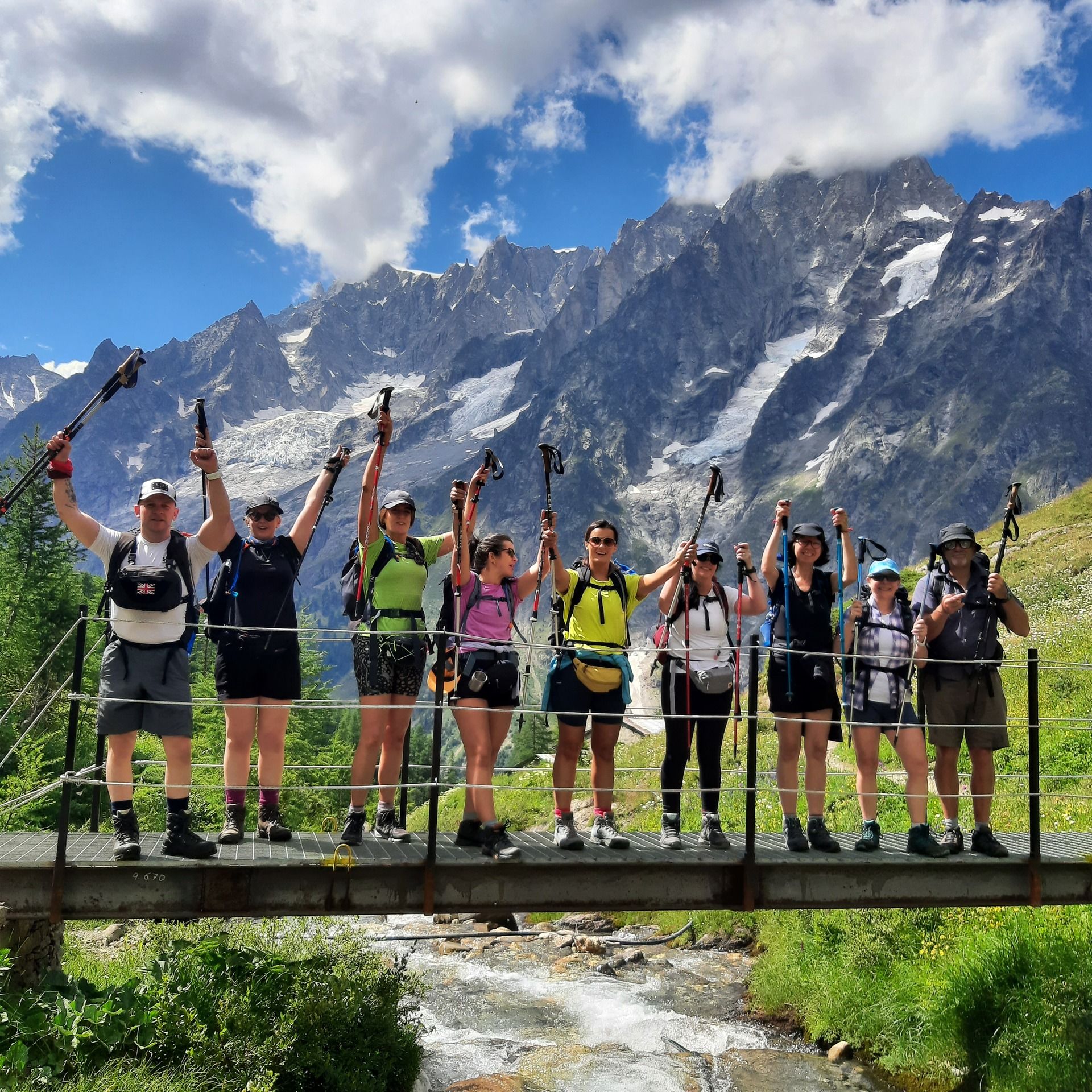
Beyond the TMB: Exploring Mont Blanc's Hiking Trails
The Tour du Mont Blanc (TMB) is renowned, yet the Mont Blanc area boasts a variety of other trails suitable for all skill levels, from family-friendly routes in Chamonix to secluded paths near Courmayeur.
Chamonix Valley Trails: Highlights include Lac Blanc and Grand Balcon Sud, known for their stunning views and accessibility. The Lac Blanc trail begins with an Index chairlift ride, followed by a 3-4 hour hike with a 500-meter elevation gain, offering spectacular alpine lake views against the Mont Blanc massif. The Grand Balcon Sud, a medium-difficulty trail, stretches between Planpraz and Flegere over 4-5 hours with a 350-meter elevation gain, providing panoramic views of the Mont Blanc massif.
Courmayeur Trails: The Italian side features trails like the Val Ferret Circuit, showcasing the Italian Alps' beauty and Mont Blanc from new perspectives. For advanced hikers, Mont de la Saxe offers a challenging route with exceptional views.
Other Training Trails: The Aosta Valley features multi-day hikes at high altitudes, such as the Alpine Panoramic Trail, with a total elevation gain of 2,700m over three days. This trail offers unique views of Mont Blanc and the Italian and Swiss Alps, presenting a challenging but rewarding experience:
❝Day 1 includes a 1,470m ascent to Tza de Flassin and Colle Vertosan, offering Mont Blanc views.
Day 2 involves a 550m climb and a 1,010m descent around Mont Fallère, revealing breathtaking trails.
On day 3 your path will take you down to the Ars Valley, circling back to Saint-Oyen/Flassin. This final stretch, a 310m climb and a 900m descent over 5 to 6 hours, wraps up your alpine adventure.
2. Alpinists in the making: The easiest routes to the Mont Blanc summit
The Goûter, Trois Monts, and Gonella Routes each offer distinct pathways to the summit of Mont Blanc, catering to climbers with a fairly high fitness level and basic mountaineering skills: they are, indeed, the most popular and easiest routes you can climb to summit the highest peak in Europe.
If climbing the summit of Mont Blanc is your lifetime dream, but you still need to build some experience, taking part to a mountaineering course for beginners on the Mont Blanc slopes and glaciers might be the best investment you can possibly make.
We’ll now dive into the description of each route, briefly pointing out their pros and cons. For a deeper understanding of each route's specifics, we’ll see you at Chapter 3 and 6.
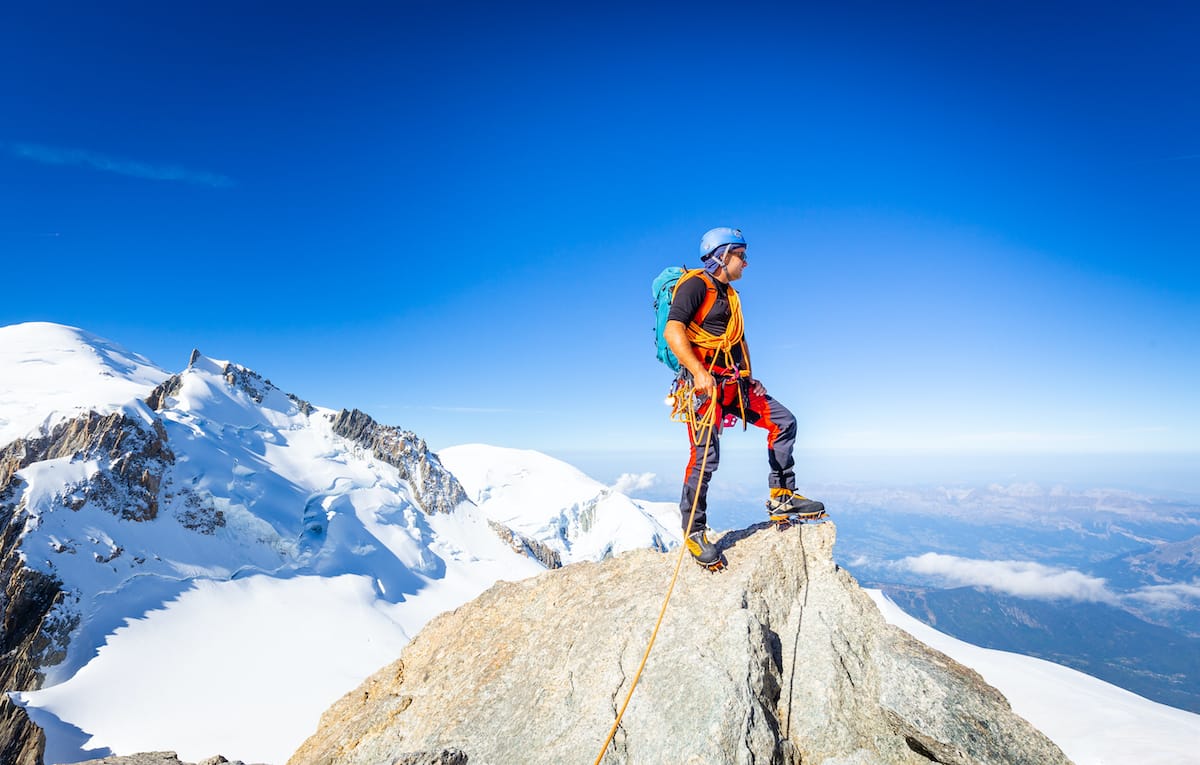
1. The Goûter Route: The Standard Path to the Summit
Often cited as the most popular and easiest route to the summit of Mont Blanc, the Goûter Route is favored by many aspiring mountaineers for its relative accessibility.
Difficulty and Duration: Classified as PD+ (Peu Difficile+, slightly difficult plus) in alpine grading, this route typically requires 2 days to complete, with an overnight stay at the Goûter Hut.
Starting Point: The adventure begins at the Nid d'Aigle, accessible via the Tramway du Mont-Blanc from Saint-Gervais, France.
Pros:
Accessibility: The Goûter Route is the most popular path to the summit, making it suitable for those with less technical climbing experience but good physical conditioning.
Hut Accommodation: The route offers the advantage of staying at the Goûter Hut, providing climbers with a chance to rest and acclimatize.
Popularity: Its popularity means the path is well-trodden and often busy, which can be reassuring for less experienced climbers.
Cons:
Crowding: The route's popularity can lead to overcrowding, especially during peak climbing seasons, which can diminish the wilderness experience.
Rockfall Hazard: The climb involves crossing the Grand Couloir, known for its rockfall risk, particularly in warm conditions.
Limited Technical Challenge: For advanced climbers seeking technical difficulty, the Goûter Route may lack the complexity and challenge of more demanding routes.
2. The Trois Monts Route: A Scenic Challenge
If you're looking for a path to the top of Mont Blanc that's both scenic and demands some technical skills, the Trois Monts Route is a great choice, but you should have some experience with varied terrains.
Difficulty and Duration: This route is considered moderately difficult (AD-, Assez Difficile-) and usually takes a full day to complete.
Starting Point: Climbers access the starting point via the Aiguille du Midi cable car from Chamonix, France.
Pros:
Offers stunning views of Mont Blanc.
It's a technical route with diverse terrains, ideal for those seeking a challenge.
It's less crowded than other routes.
Cons:
It's tougher and needs prior climbing experience.
There are risks from ice cliffs and crevasses.
Weather can greatly affect the climb.
3. The Italian Pathway: The Gonella Route
The Gonella Route offers a challenging yet scenic climb to Mont Blanc from Italy. Rated as slightly difficult (PD+), it requires two days, including an overnight at the Gonella Hut, starting from Courmayeur.
Difficulty: The Gonella Route is similar in difficulty to the Goûter Route but with its own set of challenges.
Duration: Climbers should allocate 2 days for this ascent, including an overnight stay at the Gonella Hut.
Starting Point: The journey begins in Courmayeur, Italy, with an approach to the Gonella Hut as the base for the summit push.
Pros:
The route offers stunning views of the Italian Alps, providing a scenic journey from start to finish.
The Gonella Route sees fewer climbers, offering a less crowded experience.
This route provides a well-rounded alpine climbing experience, including glacier travel.
Cons:
The ascent involves extensive glacier travel, which increases the minimum fitness level required and risk of crevasse falls.
The glacier's state highly affects the difficulty and safety of the climb.
Reaching the starting point in Courmayeur and the descent back into Italy can be logistically challenging.
3. The Rock Climber's Guide for Mont Blanc
Mont Blanc is renowned in the climbing world for its wide variety of routes, catering to both experts and beginners. It boasts an extensive selection of rock-climbing routes, each providing a distinct experience based on difficulty, length, and style.
The diversity in difficulty, length, and style means that climbers of all abilities can find routes that suit their level of expertise.
Mont Blanc area allows for genuine rock climbing adventures without needing advanced alpine skills, thanks to many routes designed for those with basic mountaineering knowledge.
These Itineraries are tailored for different proficiency levels, incorporating details such as climbing level, starting point, length, altitude, difficulty, estimated time, and required gear.
Beginner: Clocher-Clochetons Traverse
This traverse combines moderate climbing with breathtaking scenery. It's an adventurous route that involves slab and crack climbing, offering an authentic alpine experience for intermediate climbers looking to push their limits.
Starting Point: Plan de l’Aiguille, Chamonix
Length: 8 pitches
Altitude: 2,000 meters
Difficulty: 5c (French scale)
Estimated Time: Full day (6 to 8 hours)
Gear: Standard rock climbing gear, a set of nuts and cams for protection, and ropes.
Intermediate: Frison-Roche, Brévent
The Frison-Roche route is an excellent introduction to alpine rock climbing, offering spectacular views over the Mont Blanc massif.
Starting Point: Planpraz, Chamonix
Length: 6 pitches
Altitude: 2,525 meters
Difficulty: 6a (French Scale)
Estimated Time: Half-day (4 to 5 hours)
Gear: Standard rock climbing gear (harness, helmet, climbing shoes), a set of quickdraws, belay device, and ropes.
Advanced: Voie des Suisses, Exit 'O Sole Mio
A true test of endurance and skill, the Voie des Suisses offers a mix of crack, slab, and overhang climbing. It's an iconic route that provides advanced climbers with a challenging and rewarding experience.
Starting Point: Les Praz, Chamonix
Length: 10 pitches
Altitude: Start at 1,200 meters, climbing to 2,300 meters
Difficulty: III TD+ 6a
Estimated Time: Full day (8 to 10 hours)
Gear: Comprehensive rock climbing gear including cams, nuts, quickdraws, and ropes; ice axe and crampons are required for the approach and descent.
4. Other Outdoor activities you can practice around Mont Blanc
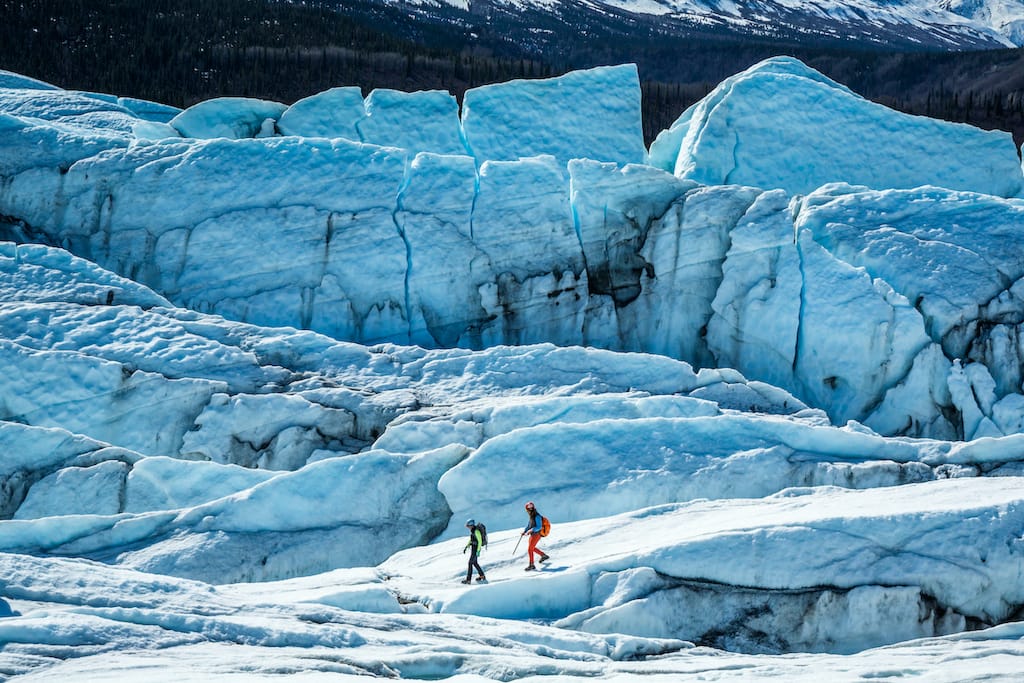
Mont Blanc is more than just a climber's dream; it offers a wide range of outdoor adventures from glacier travel, ski-touring, and ice climbing. Each activity provides a unique way to experience the mountain's natural beauty and challenges.
Glacier travel to Mont Blanc
Glacier travel in the Mont Blanc region is a fundamental skill for mountaineers: that’s why, before seeking any mountaineering goals, it’s a very popular choice to take a glacier travel course. By doing this, you’ll approach the wild environment in a soft manner and any Mountain Guide will be much more confident on supporting you on your adventure to the summit of Mont Blanc.
What to Expect: Traveling across glaciers requires skills in crevasse rescue and using specific equipment. It's a journey that combines breathtaking scenery with the thrill of overcoming nature's obstacles.
Popular Routes: The Vallée Blanche route, crossing Europe's longest glacier, is accessible and offers a firsthand look at glacier travel's allure.
Via Ferratas around Mont Blanc
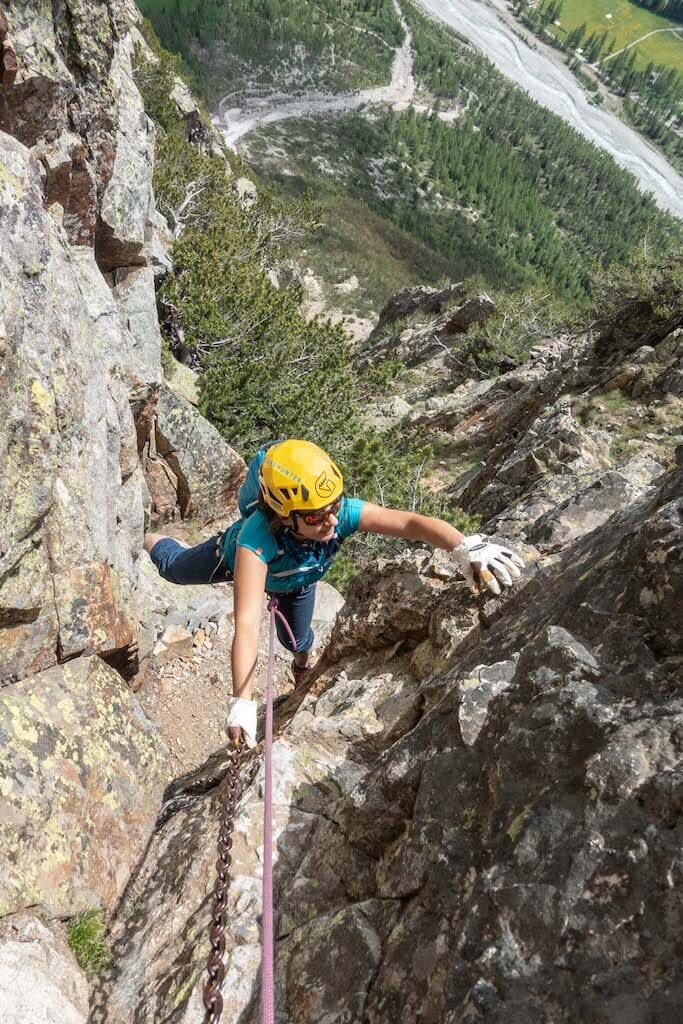
Mont Blanc's Via Ferratas are thrilling climbs that mix the excitement of scaling beautiful landscapes with the safety of established paths. They're perfect for those wanting to try a mix of climbing and hiking, with routes for various fitness levels. Some tough Via Ferratas start at Italy's Rifugio Monzino, offering a two-day adventure on Mont Blanc's south face. Meanwhile, the French side of Mont Blanc has many options for climbers looking for variety.
From Rifugio Monzino to Rifugio Borelli, Italy: Take a 2-day adventure on the Via Ferrata, starting at Rifugio Monzino and tackling Mont Blanc's south face. It's great for those with experience and fitness, combining climbing and beautiful views, perfect for small groups.
Via Ferrata des Evettes, Chamonix: Family-friendly and starting from La Flégère, this 1.5 to 2-hour journey covers 200m and includes a thrilling 50m Himalayan bridge. It's an intermediate level adventure that’s accessible and memorable.
Via Ferrata de Curalla, Passy: A short drive from Chamonix leads to this intermediate Via Ferrata, offering stunning views of Mont Blanc. It's known for its scenic beauty and provides a safe yet exciting mountain experience.
Ski-touring and Freeride around Mont Blanc
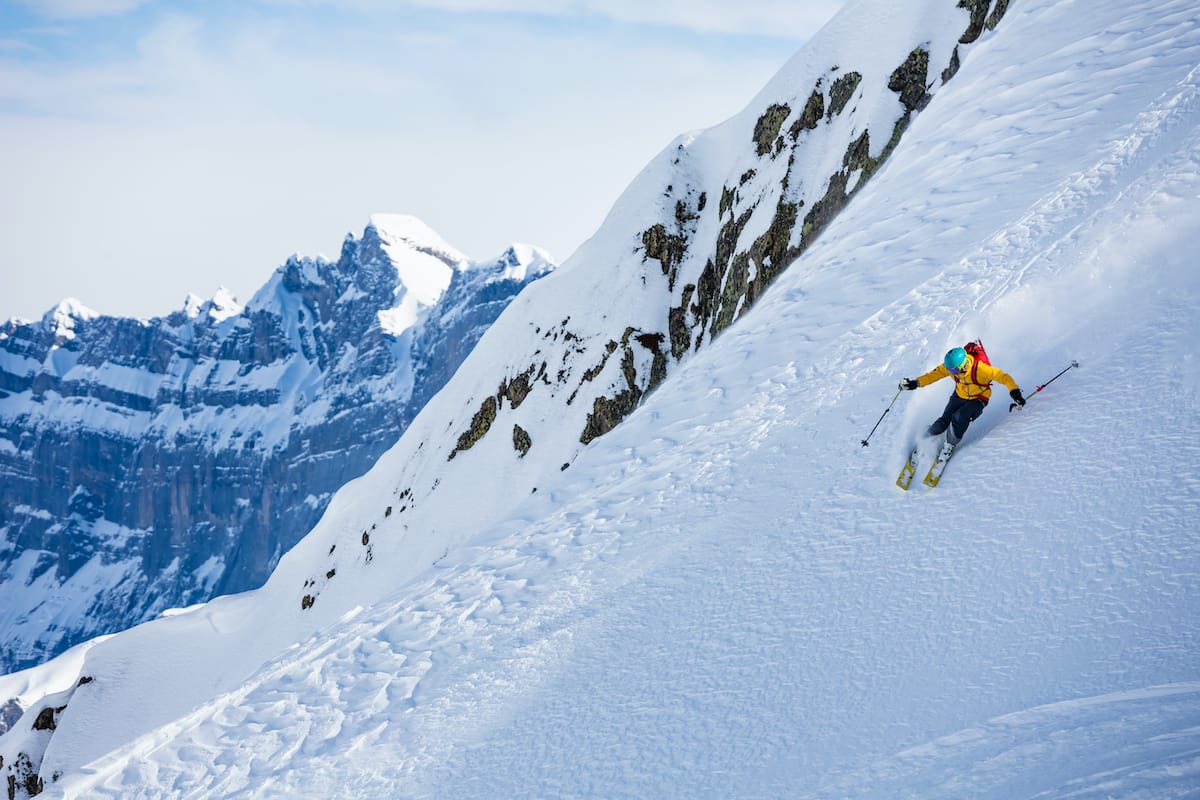
If you’re wondering if Chamonix is Good for Skiing the answer is… Absolutely. Both Chamonix and Courmayeur are excellent for skiing, thanks to reliable snow and varied slopes. Both locations cater to all skill levels.
Ski-Touring: Merges skiing and hiking for a backcountry adventure, ideal for those seeking solitude and a unique experience away from busy resorts.
Freeride Skiing: Chamonix is a mecca for freeride skiing, known for its steep slopes and deep powder. The Grands Montets area is known for steep, powder-rich slopes, drawing experienced freeride skiers globally.
Ice-climbing around Mont Blanc
Ice climbing combines climbing ice formations like frozen waterfalls with precision and strength, making Mont Blanc's surroundings an ideal place to start or challenge yourself.
Gear and Techniques: Ice climbing requires specialized gear, including ice axes, crampons, helmets, and ropes. Learning proper ice tool placement and body positioning is crucial for a successful climb.
Courses and Guides: Given the sport's inherent risks, taking an ice climbing course or hiring a guide is recommended for those new to ice climbing. We suggest to start by hiring a Professional Mountain Guide for a half-day of ice-climbing: you’ll be able to understand if this sport suits you in a relatively safe environment.
5. Costs and Budgeting for Traveling to Mont Blanc, Chamonix and Courmayeur
Embarking on an adventure around Mont Blanc, whether it's scaling its summit or trekking the Tour du Mont Blanc (TMB), requires not only physical preparation but also careful financial planning.
The cost of trekking the TMB can vary significantly based on accommodation choices, guided versus self-guided tours, and additional amenities:
Guided Tours: Prices for a 10-day guided TMB trek typically range from €1,500 to €2,500, covering guide services, accommodation, most meals, and luggage transfer. These tours are great for those who want an easy trip since they offer expert advice and help with planning. They're especially liked by people looking for a stress-free adventure. For the shorter version of the TMB hike, the cost range around 800€.
Self-Guided Ventures: For those who like to plan their own trips, self-guided tours range from €500 to €1,000. The cost varies based on where you stay and if you add meals or baggage transport. This choice needs more planning and experience but offers flexibility and might save money.
Daily Expenses: Regardless of the tour type, remember to budget for daily costs like food, drinks, and gifts, which could be about €20 to €50 each day.
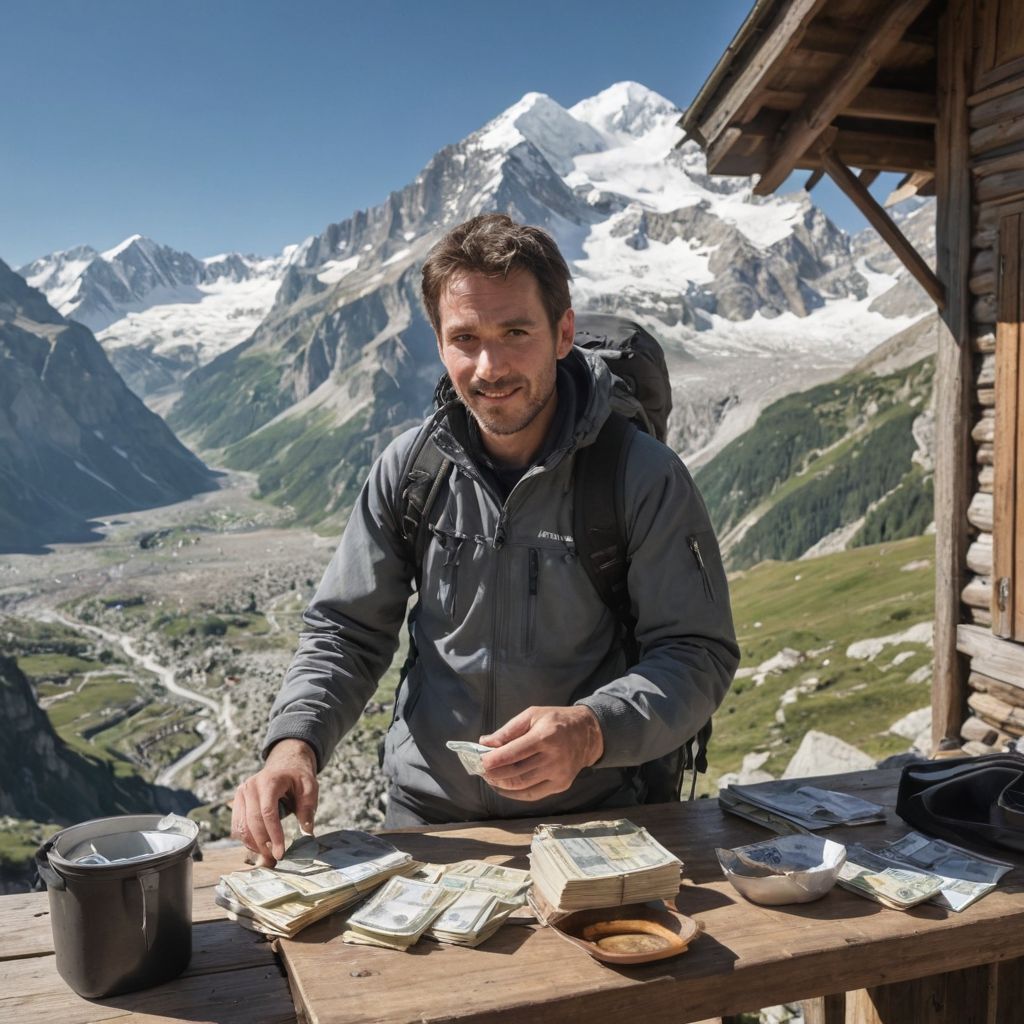
The Summit Ascent: Costs of Climbing Mont Blanc
Climbing Mont Blanc is an ambitious goal with various costs, including guide fees, gear rental, and accommodations, ranging from €1,500 to €2,000 for guided climbs and €660 to €1,350 for self-guided efforts. Costs depend on the route, whether you hire a guide, and what equipment you need.
One thing to consider is also the high demand summiting Mont Blanc generates during the high season: this requires, for example, to book guiding services and accommodations in advance. You can find more information about everything you should consider before planning a climb to Mont Blanc in Chapter 6.
Total Estimated Costs
Here’s an estimation of the budget you’ll need for guided and non-guided options for the Tour du Mont Blanc (4-day and 10-day version) and Mont Blanc Ascent. Please note these are estimations, and the price may vary based on seasonality, number of people involved and the Guiding service you’ll hire.
Expense Category | Guided 4-day TMB with Mapo Tapo | Non-Guided 4-day TMB | Guided 10-day TMB | Non-guided 10-day TMB | Guided Mont Blanc Summit | Non-Guided Mont Blanc Summit |
|---|---|---|---|---|---|---|
Accommodation | €200 | €200 | €800 | €500 | €200 | €150 |
Food and Drink (Extras) | €150 | €150 | €400 | €200 | €200 | €100 |
Transport | €50 | €50 | €100 | €100 | €150 | €150 |
Guide Fees | €350 | €0 | €800 | €0 | €800 | €0 |
Gear Rental (Optional) | €0 | €50 | €100 | €100 | €250 | €250 |
Permits/Insurance | €50 | €50 | €50 | €50 | €100 | €100 |
Total Cost | €800 | €500 | €2,250 | €950 | €1,900 | €750 |
6. Things to know before going on a climbing and hiking adventure around Mont Blanc
Continuing from our exploration of the costs associated with undertaking adventures around Mont Blanc, this chapter is useful for those planning an ascent of this iconic peak or the Tour du Mont Blanc hike.
General information
How long should you stay in Mont Blanc area?
Spending one week in Mont Blanc helps you get used to the altitude, deal with changing weather, rest well, and have time for extra activities. It's also a chance to see the local culture and nature in places like Chamonix and Courmayeur.
When is the best period to visit Mont Blanc?
For hiking and mountaineering, the summer months (May to September) provide optimal conditions, with accessible routes and safer climbing conditions. This time frame also matches the operational months of key refuges such as Refuge de Tête Rousse, Refuge du Goûter, and Refuge des Cosmiques. Winter and early spring, meanwhile, are perfect for freeride skiing and ski-touring, offering powdery snow and exhilarating slopes.
Things to know before planning your ascent of Mont Blanc
If you're dreaming of a solitary moment on the summit of Europe's highest peak, you might have to adjust your expectations. It's estimated that around 30,000 adventurers reach the summit of Mont Blanc each year, which breaks down to an average of 82 climbers daily, peaking at 200 a day in summer. This popularity means you won't be alone at the top and impacts the climbing experience.
Do I need a specific permit to climb Mont Blanc?
To tackle Mont Blanc's overcrowding and safety issues, France introduced regulations in 2018, requiring climbers on the Goûter route to book at the Gouter shelter. Although there's no permit system, steps to safeguard the environment and climbers include a 2020 decree creating a protected area, mandating hut reservations, banning bivouacking on certain routes, and establishing enforcement measures.
How to access Mont Blanc in 2024
Each route to Mont Blanc summit has its own access. The Goûter route is the most crowded one, and because of that you must book at the Goûter hut in order to access to the summit. Speaking of the Trois Monts Route and the Gonnella route, the rules are less strict:
Goûter route: To facilitate climbers' access to Mont Blanc via the Goûter route, special train services from Le Fayet to Le Nid d'Aigle are provided, operating three times daily from the season's start until October 1st. Keep reading to Chapter 7, “Best ways to access Chamonix, Courmayeur and Mont Blanc”: you’ll find all the information.
The Trois Monts Route, also known as the Three Monts Traverse, begins at the Aiguille du Midi. Climbers take the Aiguille du Midi cable car from Chamonix to the Aiguille du Midi station at 3,842 meters. This cable car, one of the highest in the world, provides direct access to the high mountains and is the common starting point for The Trois Monts Route.
The Gonella Route is accessed from the Italian side of Mont Blanc, starting near Courmayeur. The ascent typically starts with a hike to the Gonella Hut (Rifugio Gonella), situated at 3,071 meters. This mountain hut serves as the base camp for climbers taking The Gonella Route to the summit. The route from Courmayeur to the Gonella Hut involves trekking through the Val Veny and gaining significant elevation to reach the hut.
Most common hazards to be prepared for on your way to Mont Blanc
The Goûter route to Mont Blanc, while less technically demanding, poses significant dangers due to frequent rockfalls and landslides, especially in a critical corridor en route to the refuge. Historical data from 1990 to 2017 shows 102 deaths from these hazards. Seasonal melting can loosen stones, increasing landslide risks. Helmets are vital, but may not fully protect against large rockfalls. The route also crosses glacier areas, raising the risk of ice and crevasse-related accidents. Most incidents involve falling climbers, often triggered by rockfalls, with unguided or solo climbers at greater risk.
The Trois Monts Route: The early parts of the climb are technically challenging and risky due to shifting glaciers that might release large ice blocks, or "seracs," leading to avalanches. Carrying and knowing how to use avalanche safety equipment is vital for protection. Climbers must also be cautious of the route's steep slopes, particularly under the Monte Maledetto pass, where the angle can be as steep as 45 degrees, and be prepared for the difficulties of moving through areas with crevasses.
The Gonella Route: To address the dangers of glacier travel on Mont Blanc, the Aiguilles Grises ridge route was created as a safer alternative to the conventional Italian route. After three years of work, this new path avoids the risky Dome glacier, targeting seasoned climbers with its inclusion of rest spots and fixed ropes for challenging parts, extending the journey by 60-90 minutes but greatly improving safety. This route responds to the growing fragility of glaciers and increasing challenges of old paths, ensuring a safer return and preventing climbers from getting lost on the glacier.
Things to know before planning your Tour du Mont Blanc hike
Preparation is Key: Before you start the TMB, learn about the route and terrain. The trek spans several days, so it is important that you train to be steady on your feet and you build experience walking on mountain paths. Do try and get some practice in before you come.
Your To-Do List: Preparation extends beyond physical training. Organize your trip by booking flights to match the trek schedule, and getting insurance for hiking up to 3000m. Additionally, organizing currency for both Euros and Swiss Francs, and get the necessary equipment are necessary tasks to address before departure.
Currency and Expenses: Ensuring you have adequate funds in both currencies will make transactions smoother during your journey: we recommend bringing at least 100 EUR & 100CHF spending money for drinks and lunches, tips and souvenirs.
Kit and Equipment: Your backpack should not exceed 8kg, including snacks and water. Essential items include waterproof clothing, lightweight insulated jackets, hiking boots, sleeping bag liner and technical equipment like trekking poles. Personal items such as a water container, sun protection, and a small wash kit are also vital.
7. Best ways to access Chamonix, Courmayeur and Mont Blanc
Accessing Chamonix
Geneva International Airport in Switzerland is the closest airport to Chamonix, serving as the main gateway for visitors. You can travel from Geneva to Chamonix by bus, which takes about 1.5 hours, with ticket prices ranging from €30 to €50. For a scenic option, take the train from Geneva to Chamonix, requiring a change at Vallorcine. This trip costs about €40 to €60 for a one-way ticket, offering a picturesque introduction to the Alps.
Accessing Courmayeur
Geneva International Airport is also the closest major airport to Courmayeur, Italy, for those accessing Mont Blanc from this side. From Geneva, you can take a bus or rent a car for a roughly 1 hour and 45-minute journey through the Mont Blanc Tunnel directly to Courmayeur. Bus ticket prices range from €40 to €60, while car rentals are available at Geneva Airport, with a Mont Blanc Tunnel toll cost of about €60. To reach Courmayeur by train, travel to Aosta first, then continue by bus, with total fares from €40 to €65.
Ways to access Mont Blanc routes and TMB
Once you‘ve settled in Chamonix or Courmayeur, getting to the starting point of your Mont Blanc adventurers is quite straightforward:
From Chamonix:
The Aiguille du Midi Cable Car and the tramway are essential for accessing Mont Blanc's Goûter and Trois Monts routes. Adults can use the cable car for a round-trip ticket costing about €65.
The Tramway du Mont-Blanc, with departures three times daily for both ascent and descent, caters to mountaineers. To use this service, buy tickets online and show your refuge booking at the TMB ticket offices to get a special mountaineer ticket to Nid d'Aigle. This system, designed for conservation and safety, is expected to continue.
For adventurers setting out on the TMB, public transport to Les Houches is readily available, with bus and train fares costing around €3-€5 for a one-way trip. Services run from early morning until the evening, typically from 6:00 am to 8:00 pm, accommodating hikers' schedules.
From Courmayeur:
Accessing the Gonella Hut for the Italian Normal Route involves a combination of taxi or shuttle services from Courmayeur to Val Veny, with prices starting from €30-€50. Given the lack of direct public transport to this remote starting point, arranging early morning travel is advisable.
Courmayeur itself marks a significant point on the TMB, with public buses facilitating access to various segments of the trail fromaround 7:00 am to 7:00 pm, at costs ranging from €2 to €10.
7. Conclusions
Wrapping up our Mont Blanc adventure, we've covered everything from essential tips to exciting activities. This iconic peak offers everything from peaceful treks like the Tour du Mont Blanc to exhilarating via ferrata climbs. Mont Blanc caters to all, whether you're seeking serene walks or thrilling ascents. Let's look back at the sports we've explored and how you can start your own adventure.
Hiking the Tour du Mont Blanc
Taking on the Tour du Mont Blanc means traversing three countries to see the Alps' stunning vistas. It's fit for hikers of various levels, with trails passing through vibrant valleys and meadows near the glaciers. Options include a brief, 4-day route or the fuller 7 to 10-day hike. For a greater challenge, the Alpine Panoramic Trail offers distinct views and terrain, promising an unforgettable experience in either choice.
Mountaineering Around Mont Blanc
For those drawn to the high-altitude challenges of mountaineering, Mont Blanc presents the ultimate adventure. Climbing Mont Blanc requires preparation, skill, and respect for the mountain's environment. Beginners can find their footing with a beginner mountaineering course around Mont Blanc, designed to equip novices with the necessary skills in a supportive and educational setting.
Via Ferrata on the Mont Blanc Foothills
Via ferrata offers an exciting blend of climbing and safety through fixed gear, perfect for both new and seasoned adventurers. It's a chance to conquer vertical landscapes while enjoying stunning views. Mapo Tapo provides specially designed experiences, including an intermediate level via ferrata in the Mont Blanc foothills, guided by experts to ensure a safe yet challenging adventure.
Conclusion
Mont Blanc's stunning landscapes offer outdoor adventures for all. From the iconic Tour du Mont Blanc (TMB) trek, icy summit climbs, to thrilling via ferrata climbs, there's something for everyone. Mapo Tapo curates experiences for both beginners and experienced adventurers, providing expert guidance and a supportive community. Exploring Mont Blanc is not just an adventure but a journey of discovery, pushing your endurance, willpower, and appreciation for nature's beauty.
This article will be updated from time to time by editors at Mapo Tapo, in collaboration with Local Guides and Businesses, in order to provide you with the latest and most-accurate information about this destination.

